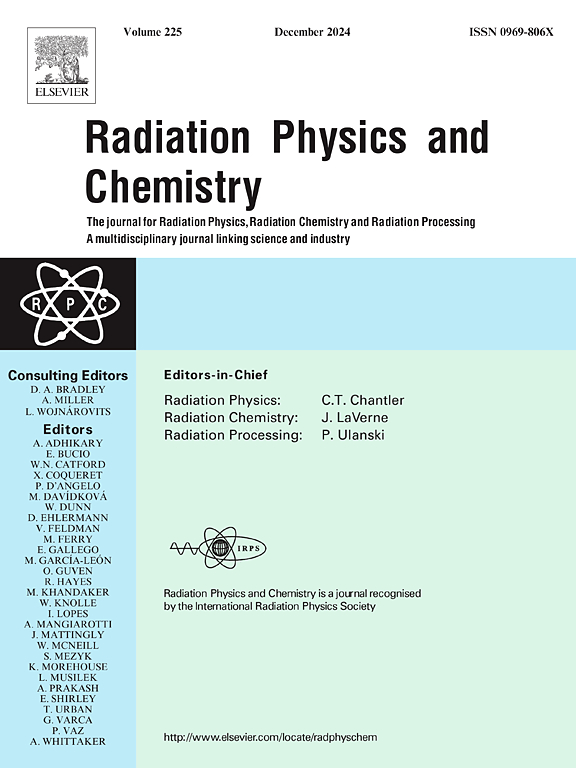New developments in monochromatic energy dispersive X-ray fluorescence instrumentation for monitoring toxic elements in food matrices: Advantages and limitations
IF 2.8
3区 物理与天体物理
Q3 CHEMISTRY, PHYSICAL
引用次数: 0
Abstract
Monochromatic excitation (M-) based on a low-power X-ray (20–50W) source with doubly curved crystal (DCC) optics has been used successfully for X-ray fluorescence (XRF) analysis of many different sample matrices. Previously, a “first-generation” M-XRF analyzer, the HD Mobile® (X-ray Optical Systems, (XOS) East Greenbush NY), was used in a field-based public health study. The HD Mobile® was optimized to detect Pb, Cd, Hg and As in consumer products, food, and cultural medications, with limits of detection (LOD) on the order of a single digit μg/g (ppm) mass fraction. In this current study, two “second generation” DCC-enabled XRF analyzers were evaluated for detecting key toxic elements in food matrices. The two instruments evaluated included: the Zmax™ XRF Analyzer and the Emax™ Analyzer, which are both manufactured by Z-Spec (East Greenbush, NY, US). The Zmax™ uses an X-ray tube operated at 35W with a single DCC optic for a 17.5-keV excitation beam optimized to detect Pb, As, Hg, Ni and Cr. A fast silicon drift detector (SDD) is used to detect fluorescence x-rays. The Emax™ uses an X-ray tube operated at 40 W with DCC optics for a 30-keV excitation beam, and a thicker 1-mm SDD optimized to detect Cd, Mo, Sb, and Sn, along with many other elements. While the primary focus of the current study was the Emax™ and Zmax™, several other XRF analyzers were available and were included for comparison purposes. They included the HD Mobile® (XOS), and two ‘conventional’ portable XRF analyzers: the Niton™ XL3t GOLDD XRF, and the Niton™ XL5 Plus, both manufactured by ThermoFisher Scientific (Tewksbury, MA). Z-Spec used certified reference materials (CRMs) to optimize the Fundamental Parameters algorithm for the Zmax™ and Emax™ analyzers to achieve acceptable performance for key toxic elements in biological matrices. For the Zmax™, difference plots show good agreement between found values and CRM assigned values for the elements studied (Pb, As, Cu, Mn, Ni, Hg and Zn). For the Emax™, there was good agreement for values obtained for Cd in CRMs. Archived food-based proficiency test (PT) samples were analyzed to assess the performance of the Zmax™ and Emax™ as screening tools to detect key elements. Some of the PT samples were also analyzed using the two Niton™ XRF instruments as well as the HD Mobile® for comparison purposes. These PT samples were spiked with toxic elements and circulated by the FDA to US-based public health laboratories funded under the Food Emergency Response Network (FERN), with target values assigned based on consensus data obtained from analyses based on Inductively Coupled Plasma Mass Spectrometry (ICP-MS). For the FERN 2022 PT samples (sausage meat), which were spiked with Tl, Cd and Pb, Zmax™ values were within the tolerance range required for ICP-MS analysis. Estimated LODs in μg/g (ppm) were: Pb, 0.06; Tl, 0.06; Hg, 0.06; Cd, 0.04; and Sn, 0.11. Several ‘real-world’ samples were analyzed using the Zmax™ and Emax™ devices, including medicinal herbs such as moringa and pot marigold, as well as various spices like cloves, coriander, and curry.
单色能量色散x射线荧光仪器监测食品基质中有毒元素的新进展:优点和局限性
基于双弯曲晶体(DCC)光学的低功率x射线(20-50W)源单色激发(M-)已成功地用于许多不同样品矩阵的x射线荧光(XRF)分析。此前,“第一代”M-XRF分析仪HD Mobile®(x射线光学系统,(XOS) East Greenbush NY)被用于基于现场的公共卫生研究。经优化,HD Mobile®可检测消费品、食品和文化药物中的Pb、Cd、Hg和As,检出限(LOD)为个位数μg/g (ppm)质量分数。在目前的研究中,评估了两种“第二代”dcc -启用XRF分析仪用于检测食品基质中的关键有毒元素。评估的两种仪器包括:Zmax™XRF分析仪和Emax™分析仪,它们都是由Z-Spec (East Greenbush, NY, US)制造的。Zmax™使用35W的x射线管,带有单个DCC光学器件,17.5 kev激发光束优化检测Pb, As, Hg, Ni和Cr。快速硅漂移检测器(SDD)用于检测荧光x射线。Emax™使用40 W的x射线管和DCC光学器件,用于30 kev的激发光束,以及更厚的1 mm SDD,用于检测Cd, Mo, Sb和Sn以及许多其他元素。虽然目前研究的主要焦点是Emax™和Zmax™,但也有其他几种XRF分析仪可供比较。它们包括HD Mobile®(XOS)和两个“传统”便携式XRF分析仪:Niton™XL3t gold XRF和Niton™XL5 Plus,均由ThermoFisher Scientific (Tewksbury, MA)制造。Z-Spec使用经过认证的标准物质(crm)来优化Zmax™和Emax™分析仪的基本参数算法,以达到生物基质中关键有毒元素的可接受性能。对于Zmax™,差异图显示了所研究元素(Pb, As, Cu, Mn, Ni, Hg和Zn)的发现值与CRM分配值之间的良好一致性。对于Emax™,在crm中获得的Cd值有很好的一致性。对存档的食品能力测试(PT)样本进行分析,以评估Zmax™和Emax™作为检测关键元素的筛选工具的性能。一些PT样品也使用两种Niton™XRF仪器以及HD Mobile®进行分析,以进行比较。这些PT样品中添加了有毒元素,并由FDA分发给由食品应急响应网络(FERN)资助的美国公共卫生实验室,并根据电感耦合等离子体质谱(ICP-MS)分析获得的共识数据分配目标值。对于添加了Tl、Cd和Pb的FERN 2022 PT样品(香肠肉),Zmax™值在ICP-MS分析所需的公差范围内。以μg/g (ppm)计算的lod值为:Pb, 0.06;Tl, 0.06;Hg, 0.06;Cd, 0.04;Sn为0.11。使用Zmax™和Emax™设备分析了几个“真实世界”的样本,包括辣木和万寿菊等草药,以及丁香、香菜和咖喱等各种香料。
本文章由计算机程序翻译,如有差异,请以英文原文为准。
求助全文
约1分钟内获得全文
求助全文
来源期刊

Radiation Physics and Chemistry
化学-核科学技术
CiteScore
5.60
自引率
17.20%
发文量
574
审稿时长
12 weeks
期刊介绍:
Radiation Physics and Chemistry is a multidisciplinary journal that provides a medium for publication of substantial and original papers, reviews, and short communications which focus on research and developments involving ionizing radiation in radiation physics, radiation chemistry and radiation processing.
The journal aims to publish papers with significance to an international audience, containing substantial novelty and scientific impact. The Editors reserve the rights to reject, with or without external review, papers that do not meet these criteria. This could include papers that are very similar to previous publications, only with changed target substrates, employed materials, analyzed sites and experimental methods, report results without presenting new insights and/or hypothesis testing, or do not focus on the radiation effects.
 求助内容:
求助内容: 应助结果提醒方式:
应助结果提醒方式:


